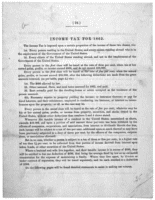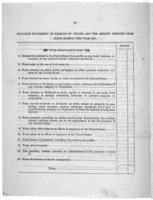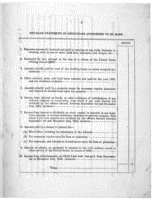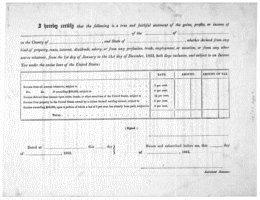 SKC Films Library SKC Films Library |
| SKC Films Library >> Economics >> Revenue and Taxation |
| The United States' First Income Tax Soon after the Civil War erupted Congress passed the Revenue Act of 1861, which restored earlier excises taxes and imposed a tax on personal incomes. The nation's first income tax was levied at 3 percent on all incomes higher than $800 a year. This tax on personal income was a new direction for a Federal tax system based mainly on excise taxes and customs duties. Certain inadequacies of the income tax were quickly acknowledged by Congress and thus none was collected until the following year. By the spring of 1862 it was clear the war would not end quickly, and with the Union's debt growing at the rate of $2 million daily it was equally clear the Federal government would need additional revenues. On July 1, 1862 Congress passed the Internal Revenue Act of 1862, which placed excise taxes on such items as playing cards, gunpowder, feathers, telegrams, iron, leather, pianos, yachts, billiard tables, drugs, patent medicines, and whiskey. Many legal documents were also taxed and license fees were collected for almost all professions and trades. The 1862 law also made important reforms to the Federal income tax that presaged important features of the current tax. A two-tiered rate structure was enacted, with taxable incomes up to $10,000 taxed at a 3 percent rate and higher incomes taxed at 5 percent. A standard deduction of $600 was enacted and a variety of deductions were permitted for such things as rental housing, repairs, losses, and other taxes paid. In addition, to assure timely collection, taxes were "withheld at the source" by employers. To administer the excise and income taxes, the act established the office of Commissioner of Internal Revenue. The Commissioner was given the power to assess, levy, and collect taxes, and the right to enforce the tax laws through seizure of property and income, as well as through prosecution. Below are pictures of an actual 1862 income tax form and accompanying instructions; click on each for a full view. [from the Library of Congress] In 1866, internal revenue collections reached their highest point in the nation's 90-year history -- more than $310 million, an amount not reached again until 1911. The need for Federal revenue declined sharply after the war and most taxes were repealed. By 1868, the main source of Government revenue was liquor and tobacco taxes, and the income tax was abolished in 1872. SEE ALSO |
| SKC Films Library
>> Economics >> Revenue and Taxation This page was last updated on June 25, 2017. |



